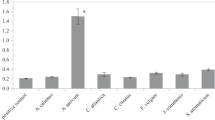Abstract
Plant essential oils possess diversified insecticidal properties. Under screening programme of survey of bioactive agents for insect control 31 essential oils from different botanicals (2% in acetone), were studied for repellency and direct toxicity (insecticidal) against laboratory bred houseflies, Musca domestica L. The essential oils obtained from Ocimum gratissimum L., Thymus serpyllum L., lllicium verum Hooks, f., Myristica fragrans Houtt., Curcuma amada Roxb. showed 100% repellent activity, and Acorus calamus L. and Thymus serpyllum L. showed about 40% insecticidal activity. Results were compared with N, N-diethyl-meta-toluamide, dimethyl phthalate, malathion, pyrethrum extract, thymol, mineral oil and piperonylbutoxide. Biochemical studies of these promising oils may emerge new leads in developing future pesticides.
Résumé
Les huiles essentielles des plantes possèdent des propriétés multiples. Au cours d’un programme d’évaluation de substances biologiques actives pour la lutte contre les insectes, 31 huiles essentielles provenant de différents extraits botaniques dans 2% d’acétone ont été testées pour leur pouvoir répulsif et leur toxicité directe (insecticide) sur des mouches domestiques élevées au laboratoire. Les huiles essentielles obtenues de Ocimum pratissimum L.,Thymus serphyllum L, lllicium verum Hooks.f., Myristica fragrans Houli.,Curcuma amada Roxb. ont induit 100% d’activité repulsive alors que Acorus calamus L., et Thymus serphyllum L.,ont montré une activité insecticide de 40 % environ. Les résultats furent comparés à ceux de N,N-diethyl-meta-toluamide, de dimethyl phthalate, du malathion, d’extrait de pyrèthre, de thymol, d’huile minérale et de pyperonylbutoxide. Des études biochimiques de ces huiles prometteuses pourraient se dégager de nouvelles perspectives pour le développement de nouvelles molécules de pesticides.
Similar content being viewed by others
References
Abbott W. S. (1925) A method of computing the effectiveness of an insecticide. J. econ. Entomol. 18, 265–267.
Anonymous (1985) Perfume repellent. New Scientist. 105, 21.
Brattsten L. (1979) Drug metabolism. In Herbivores, Their Interaction with Secondary Plant Metabolites (Edited by Rosenthal G. A. and Janzen D. H.), p. 35. Academic, New York.
Brattsten L. B., Holyoke Jr. C. W., Leeper J. R. and Rafa K. F. (1986) Insecticide resistance: Challenge to pest management and basic research. Science 231, 1255–1260.
Dongre T. K. and Rahalkar G. W. (1982) Effect of Blumea eriantha (Compositae) oil on reproduction in Earias vittella F. Experientia 38, 98–99.
Guenther E. (1948) The Essential Oils. Vol. 1, D. Van Nostrand, New York.
Iwuala M. O. E., Osisiogu I. U. W. and Agabakwuru E. O. P. (1981) Dennettia oil a potent new insecticide: Tests with adults and nymphs of Periplaneta americana and Zonocerus variegatus. J. econ. Entomol. 74, 249–252.
Kulkarni R. A. (1986) The future of pest control and pesticide industry. Pure Appi. Chem. 58, 917–924.
Satyavati G. V., Raina M. K. and Sharma M. (1976) Medicinal Plants of India. Indian Council of Medical Research. Cambridge Printing Works, Delhi, India, pp. 488.
Sawhney S. S., Suri R. K. and Thind T. S. (1977) Antibacterial efficacy of some essential oils in vitro. Indian Drugs 15, 30.
Saxena B. P., Kaul O., Tikku K. and Atal C. K. (1977) A new insect chemosterilant isolated from Acorus calamus L. Nature London 270, 512–513.
Singh D. and Agrawal S. K. (1988) Himachalol and ß-Himachalene: Insecticidal principles of Himalayan cedarwood oil. J. Chem. Ecol. 14, 1145–1151.
Singh D. and Jain D. C. (1987) Relative toxicity of various organic solvents generally used in screening plant products for insecticidal activity against the housefly Musca domestica L. Indian J. Exp. Biol. 25, 569–570.
Singh D. and Rao S. M. (1985) Toxicity of cedarwood oil against pulse beetle Callosobruchus chinensis Linn. Indian Perf. 29, 201–204.
Singh D. and Rao S. M. (1986) Effect of cedarwood oil on reproduction of Dysdercus koenigii (F.). Curr. Sci. 55, 422–423.
Singh D., Rao S. M. and Tripathi A. K. (1984) Cedarwood oil as a potential insecticidal agent against mosquitoes. Naturwiss. 71, 265–266.
Singh D., Siddiqui M. S. and Sharma S. (1988) Reproduction retardant and fumigant properties in essential oils against rice weevil (Coleoptera: Curculionidae) in stored wheat. J. econ. Entomol. 82, 727–737.
Author information
Authors and Affiliations
Additional information
CIMAP Publication approval No. 815.
Rights and permissions
About this article
Cite this article
Singh, D., Singh, A.K. Repellent and Insecticidal Properties of Essential Oils Against Housefly, Musca Domestica L.. Int J Trop Insect Sci 12, 487–491 (1991). https://doi.org/10.1017/S1742758400011401
Received:
Revised:
Published:
Issue Date:
DOI: https://doi.org/10.1017/S1742758400011401




